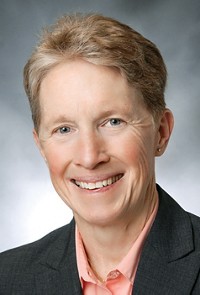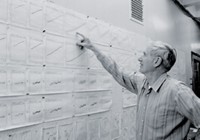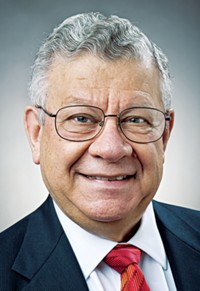Advertisement
Grab your lab coat. Let's get started
Welcome!
Welcome!
Create an account below to get 6 C&EN articles per month, receive newsletters and more - all free.
It seems this is your first time logging in online. Please enter the following information to continue.
As an ACS member you automatically get access to this site. All we need is few more details to create your reading experience.
Not you? Sign in with a different account.
Not you? Sign in with a different account.
ERROR 1
ERROR 1
ERROR 2
ERROR 2
ERROR 2
ERROR 2
ERROR 2
Password and Confirm password must match.
If you have an ACS member number, please enter it here so we can link this account to your membership. (optional)
ERROR 2
ACS values your privacy. By submitting your information, you are gaining access to C&EN and subscribing to our weekly newsletter. We use the information you provide to make your reading experience better, and we will never sell your data to third party members.
Environment
ACS Climate Science Toolkit: A New Resource For Members
by Bassam Z. Shakhashiri
December 3, 2012
| A version of this story appeared in
Volume 90, Issue 49

The American Chemical Society is among the major scientific organizations that have issued position statements acknowledging the reality of climate change and recommending action on this great global challenge. The ACS policy statement (www.acs.org/policy) says that people need a basic understanding of climate science to make informed personal decisions, and it describes climate-change education for the public as “essential.” I believe that it is the responsibility not only of ACS but also of individual members to take active roles in this education process both as scientists and citizens. It is our responsibility as scientist-citizens to use our knowledge, as our ACS mission statement expresses so eloquently, “for the benefit of Earth and its people.” I strongly urge all ACS members in the U.S. and around the world to participate in this education process, and one of my ACS presidential initiatives has been to provide reliable and valid tools for doing so.
About a year ago, with my term as ACS president drawing near, I formed the ACS Presidential Working Group on Climate Science, a panel of distinguished scientists and science communicators chaired by Jerry A. Bell of the University of Wisconsin, Madison (C&EN, Nov. 21, 2011, page 40).
The panel began work in late October 2011 on two tasks: One was to develop a tool kit that ACS members could use for self-education to understand the fundamental chemical and physical processes that determine Earth’s climate. The second was to develop strategies for ACS members to use in disseminating climate science information to the public in ways that expand upon the ACS policy statement.
I am delighted that the first task of this major initiative is complete and that these resources are now available as the ACS Climate Science Toolkit (www.acs.org/climatescience). I invite your comments at climatescience@acs.org.
All of us are engaged in staying abreast of the science in our own fields. Lewis Carroll’s Red Queen in “Through the Looking-Glass” could have been commenting on the pace of 21st-century science with the famous observation, “It takes all the running you can do, to keep in the same place.” Although we may be interested in climate change, we may not have convenient access to reliable resources to help develop an understanding of the fundamental chemical and physical processes that determine Earth’s climate. We must be confident in and comfortable with our knowledge of climate science to successfully communicate with the public.
The ACS Climate Science Toolkit provides ACS members with the information and other resources necessary to develop a robust intellectual structure to communicate on this key topic. It explains the greenhouse gas effect, how Earth’s heating mechanism works, how the vibrational energy from molecules changes into translational kinetic energy, and much more.
The kit also provides a package of “Climate Science Narratives” and PowerPoint slides that can be adapted and personalized for when ACS members have the opportunity to speak publicly about climate science. Our audiences include students, schoolteachers, college and university faculty, industrial scientists and business leaders, civic and religious groups, professional science and educational organizations, and elected public officials at all levels and in all branches of government.
Today’s milieu for climate science may have a historical antecedent: the late-20th-century controversy over whether chlorofluorocarbons in aerosol sprays and other products threatened the layer of stratospheric ozone that protects life on Earth. The debate spanned the 1970s through the 1990s. Eventually, however, the science was accepted. It led to worldwide government action to ban CFCs and related compounds. The 1995 Nobel Prize in Chemistry recognized F. Sherwood Rowland, Mario J. Molina, and Paul J. Crutzen for their work in averting an environmental catastrophe.
Rowland was a model for today’s scientist-citizens who might consider using the ACS Climate Science Toolkit to communicate about climate change. With great persistence for years on end, Rowland engaged audiences as varied as students and members of the U.S. Congress. His focus on the science of CFCs and stratospheric ozone fostered government action. As he mused at one White House event in 1997: “Isn’t it a responsibility of scientists, if you believe that you have found something that can affect the environment, isn’t it your responsibility to actually do something about it, enough so that action actually takes place? If not us, who? If not now, when?”
Views expressed on this page are those of the author and not necessarily those of ACS.






Join the conversation
Contact the reporter
Submit a Letter to the Editor for publication
Engage with us on Twitter